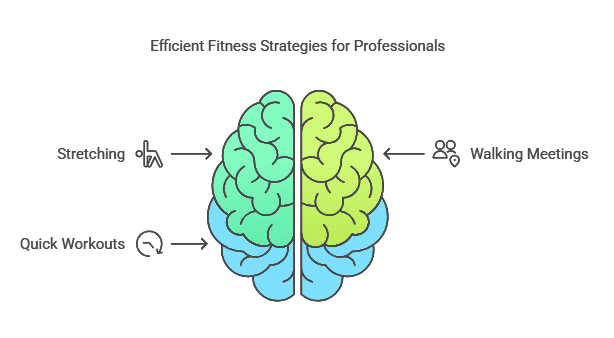In today’s fast-paced world, professionals are under immense pressure to excel in their careers while maintaining a balanced personal life. However, achieving success often comes at the expense of mental health. The growing emphasis on mental wellness highlights the need for individuals to adopt practices that safeguard their well-being.
This article delves into 10 habits of professionals who prioritize mental wellness, offering actionable insights to help you thrive both personally and professionally.
Research shows that over 76% of professionals experience workplace stress, underscoring the importance of proactive mental wellness strategies. Let’s explore these 10 habits of professionals who prioritize mental wellness to create a sustainable approach to mental health.
Habit 1: Establishing a Morning Routine
Why Morning Routines Matter
A structured morning routine sets the tone for the day, enabling professionals to start with clarity and purpose. By dedicating the first moments of the day to intentional practices, individuals can build resilience and enhance their focus. Morning routines also help create a sense of control over the day, which is critical for mental wellness.
Example: A marketing executive shares how spending 10 minutes journaling every morning reduces anxiety before presentations and boosts creativity for campaigns.
Elements of a Healthy Morning Routine
- Mindfulness Practices: Incorporate activities like meditation or journaling to calm the mind and set intentions.
- Nourishing Breakfast: Fuel your body with a balanced meal to maintain energy levels and focus.
- Planning the Day: Spend a few minutes reviewing priorities to stay organized and productive.
Table: Sample Morning Routine
| Time | Activity | Purpose |
| 6:30 AM | Meditation | Center the mind and reduce stress |
| 7:00 AM | Healthy breakfast | Boost energy and focus |
| 7:30 AM | Day planning | Organize tasks and set goals |
Habit 2: Setting Boundaries Between Work and Personal Life
The Role of Boundaries in Mental Wellness
Professionals who prioritize mental wellness understand the importance of separating work from personal life. Clear boundaries help prevent burnout and foster a sense of control. Maintaining boundaries is also essential for nurturing personal relationships and avoiding overcommitment.
Case Study: A software engineer reduced overtime by instituting a hard stop at 6 PM, improving family dynamics and reducing feelings of burnout.
Tips for Defining Clear Boundaries
- Designate specific hours for work and leisure to create structure.
- Create physical work-free zones in your home to separate environments.
- Communicate boundaries effectively with colleagues and loved ones to manage expectations.
Table: Work-Life Balance Strategies
| Strategy | Benefit |
| Designating work hours | Reduces overworking and fatigue |
| Work-free zones | Improves relaxation and family time |
| Clear communication | Prevents misunderstandings |
Habit 3: Practicing Regular Physical Activity
The Connection Between Physical and Mental Health
Physical activity is a cornerstone of mental wellness. Exercise reduces stress, releases endorphins, and boosts overall mood, making it a non-negotiable habit for thriving professionals. Regular movement also enhances focus and creativity, critical for professional success.
Insight: According to the CDC, just 30 minutes of moderate exercise five times a week can significantly lower stress levels and improve sleep quality.
Work-Friendly Fitness Tips
- Take short walks during breaks to stay active.
- Opt for standing desks or stretch at your workspace.
- Incorporate virtual fitness classes or quick home workouts into your routine.
Table: Simple Fitness Ideas for Busy Professionals
| Activity | Duration | Mental Wellness Benefit |
| Stretching | 5 minutes | Reduces tension and improves focus |
| Walking meetings | 20 minutes | Combines productivity with exercise |
| Quick workouts | 15 minutes | Boosts energy and reduces stress |
Habit 4: Prioritizing Quality Sleep
Why Sleep is Essential for Mental Health
Sleep directly impacts cognitive function, emotional stability, and physical health. Professionals who prioritize mental wellness ensure they get adequate rest to stay sharp and balanced. A well-rested mind is more resilient to stress and better equipped to handle challenges.
Stat: Studies reveal that professionals who sleep fewer than 6 hours per night are 30% less productive than those who get at least 7-8 hours.
Sleep Optimization Tips
- Establish a consistent sleep schedule, even on weekends.
- Limit exposure to screens and blue light an hour before bed.
- Create a calming bedtime routine, such as reading, stretching, or practicing relaxation techniques.
Table: Sleep Hygiene Tips
| Tip | Benefit |
| Consistent schedule | Regulates internal clock |
| Screen time reduction | Promotes deeper sleep |
| Relaxing bedtime routine | Reduces stress and improves sleep quality |
Habit 5: Seeking Support and Connection
The Power of Professional Networks and Personal Relationships
Isolation can be detrimental to mental wellness. Building strong professional and personal connections provides support, guidance, and a sense of belonging. Collaborative relationships can also foster innovation and reduce feelings of stress.
Real-Life Example: A project manager joined a local entrepreneur meetup, gaining both mentorship and emotional support during career transitions.
Ways to Build a Supportive Network
- Join industry-specific groups, associations, or online communities to connect with peers.
- Schedule regular check-ins with mentors, peers, or friends for mutual support.
- Attend networking events to expand your circle of support and gain fresh perspectives.
Table: Networking Activities and Benefits
| Activity | Benefit |
| Joining associations | Access to resources and support |
| Regular check-ins | Strengthens relationships |
| Networking events | Expands connections and opportunities |
Habit 6: Practicing Mindfulness and Meditation
The Benefits of Mindfulness for Professionals
Mindfulness reduces stress and enhances focus by grounding individuals in the present moment. Professionals who prioritize mental wellness often use mindfulness to navigate challenges calmly and effectively. It also helps improve emotional regulation and decision-making.
Fact: A Harvard study found that mindfulness can reduce work-related stress by up to 25%.
Simple Mindfulness Practices
- Try deep breathing exercises during stressful moments to regain focus.
- Dedicate 5-10 minutes daily to guided meditations to build consistency.
- Use mindfulness apps to stay committed to your practice.
Table: Mindfulness Techniques
| Technique | Time Needed | Benefit |
| Deep breathing | 2 minutes | Reduces immediate stress |
| Guided meditations | 10 minutes | Enhances focus and clarity |
| Journaling | 5 minutes | Helps process emotions and reflect |
Habit 7: Managing Time Effectively
The Link Between Time Management and Mental Wellness
Time management plays a crucial role in maintaining mental wellness. Professionals who prioritize their mental health often employ structured schedules to reduce anxiety and increase productivity. Efficient time management allows individuals to allocate energy effectively, ensuring work-life balance.
Example: A financial analyst who uses time-blocking techniques reports better task completion rates and reduced stress levels.
Time Management Techniques
- Prioritize Tasks: Use tools like the Eisenhower Matrix to distinguish between urgent and important tasks.
- Set Realistic Deadlines: Break projects into smaller steps to stay on track.
- Utilize Productivity Apps: Tools like Trello or Asana can help manage tasks efficiently.
Table: Time Management Tools and Benefits
| Tool | Purpose | Benefit |
| Eisenhower Matrix | Task prioritization | Reduces overwhelm |
| Trello/Asana | Task organization | Enhances clarity and focus |
| Time-blocking | Allocating time for specific tasks | Increases productivity and control |
Habit 8: Engaging in Continuous Learning
Mental Stimulation Through Lifelong Learning
Continuous learning fosters mental agility and growth, keeping professionals curious and adaptable. By acquiring new skills and knowledge, professionals enhance their confidence and creativity.
Insight: Research from LinkedIn shows that 94% of employees say they would stay longer at companies that invest in their learning.
Ways to Incorporate Learning into a Busy Schedule
- Listen to industry-specific podcasts during commutes.
- Dedicate 15-20 minutes daily to reading articles or books.
- Participate in webinars or short online courses tailored to your field.
Table: Learning Resources
| Resource Type | Example Platforms | Benefit |
| Online courses | Coursera, LinkedIn Learning | Develops new professional skills |
| Podcasts | The Daily Stoic, WorkLife by TED | Encourages reflective thinking |
| Industry publications | Harvard Business Review, Forbes | Keeps you updated with trends |
Habit 9: Focusing on Gratitude and Positivity
How Gratitude Enhances Mental Wellness
Professionals who prioritize gratitude experience reduced stress and increased happiness. Focusing on positive aspects of life fosters resilience and improves interpersonal relationships.
Example: A team leader who practices daily gratitude journaling reported a noticeable improvement in workplace morale and collaboration.
Daily Gratitude Practices
- Write down three things you are grateful for every morning.
- Share appreciation notes with colleagues or loved ones.
- Reflect on personal achievements to build self-confidence.
Table: Gratitude Practices and Outcomes
| Practice | Frequency | Outcome |
| Gratitude journaling | Daily | Enhances positivity and mindfulness |
| Sharing appreciation notes | Weekly | Strengthens relationships |
| Personal reflection | Monthly | Boosts self-esteem and motivation |
Habit 10: Taking Breaks and Disconnecting
The Importance of Regular Breaks
Frequent breaks are essential for recharging mental energy and preventing burnout. Professionals who prioritize mental wellness recognize that stepping away can improve focus and creativity.
Case Study: A graphic designer implemented the Pomodoro technique, resulting in fewer errors and higher creative output.
Techniques for Effective Breaks
- Pomodoro Technique: Work in 25-minute intervals followed by a 5-minute break.
- Tech-Free Zones: Dedicate specific periods to disconnect from devices.
- Engage in Hobbies: Use breaks for activities that bring joy and relaxation.
Table: Break Activities and Mental Wellness Benefits
| Activity | Duration | Mental Wellness Benefit |
| Short walks | 10 minutes | Boosts mood and reduces stress |
| Hobby engagement | 20-30 minutes | Encourages relaxation and creativity |
| Stretching | 5 minutes | Relieves tension and improves focus |
Wrap Up
Embracing the 10 Habits of Professionals Who Prioritize Mental Wellness
These 10 habits of professionals who prioritize mental wellness are more than just good practices; they are essential for thriving in demanding environments. By implementing these strategies, you can enhance your focus, resilience, and overall well-being. Start with one habit at a time, and gradually build a routine that works for you.
Prioritizing mental wellness is an ongoing journey. Share your progress, inspire others, and make mental health a cornerstone of your professional success.





































